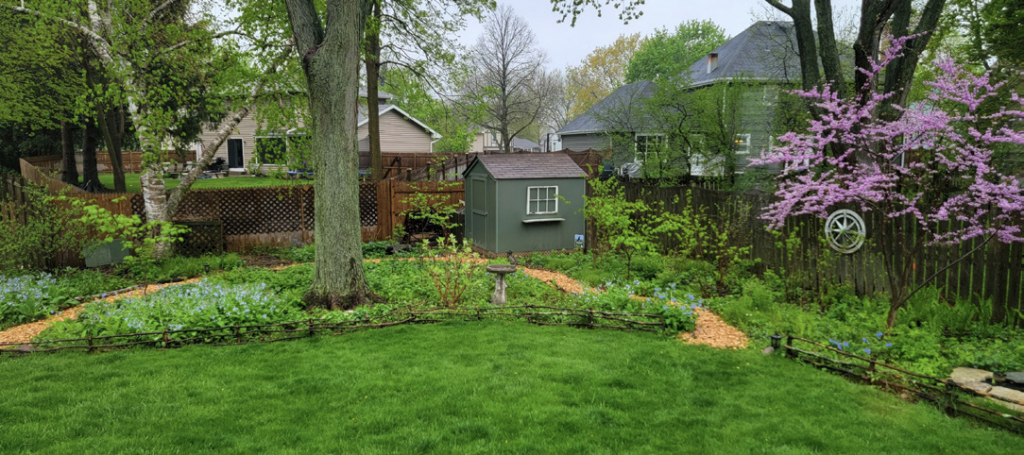A native garden is a work in progress, Dave Neu says, with the plants teaching you where they want to be.
Neu, owner of NatureSpace LLC of Libertyville, Illinois, says he’s constantly learning which species can be aggressive and which ones are well-behaved. And those experiences help him not only create better landscape designs, but also planting lists.
“I’ve learned zigzag goldenrod (Solidago flexicaulis) is very aggressive,” Neu says. “I started with three plants in a shaded area, and they have pushed everything else out in half of the backyard.”

This summer, Neu plans to thin out the goldenrod and plant some blue mistflower (Conoclinium coelestinum), which can also be aggressive.
“I figure the two plants can fight it out,” he says. “Also, there is virgin’s bower (Clematis virginiana) covering an 8-foot trellis/wall that has outgrown its welcome. I am constantly pulling up little vines throughout the garden.”
Neu says he plans to move those clematis plants to the back fence, and plant passionflower vines (Passiflora incarnata) in their place on the trellis. He acknowledges that passion flower is a bit out of its range, but figures it is worth a try. Neu says after learning which plants tend to self-seed a little too readily, he has gotten better at clipping off seed heads before the seeds disperse.
Neu says he became interested in native plants as a child exploring the forests and lakeshores of northern Wisconsin.
“I have a degree in wildlife management, biology and resource management, which led to a long and varied career in natural resources,” he says. “I’ve planned, restored and managed tens of thousands of acres of native habitat throughout the Midwest. Beginning with my parents’ backyard when I was in college, I’ve utilized native plants in the landscape of every place I’ve lived.”
He encourages those new to native landscaping to start small, just as he did on his own property.

“I first removed the nonnative invasive species such as burning bush and Japanese barberry, then I removed the Japanese yews from the foundation planting,” he says. But he and his wife decided to keep some nonnative and non-invasive plants, such as irises, peonies and hydrangeas, which they moved to the side of their house in an area they call their “Secret Garden.”
They worked on their backyard first, and then the front yard. The backyard has a rain garden, sunny prairie species and a shaded wood- land area. There is also a small tiered pond, about 6-feet by 3-feet at the bottom section and 2-feet by 3-feet at the top section, with native emergent species in containers.
The pond — an addition to the yard done for Lisa —has been a magnet for wildlife. It has been home to green frogs, bullfrogs, and American toads, Neu says, and a lot of birds use it, as well as his bird bath.
The front yard has mostly low-growing native shrubs and herbaceous species, and a patch of lawn in the middle. Neu said he hasn’t had any neighbors complain about his front landscaping, but he does keep it more orderly than the back- yard so it is obvious that it is intentional.

He also has a Conservation at Home sign and a NatureSpace sign that make it obvious that the landscape is native. It’s been the lone oasis for wildlife in his neighborhood, with thousands of native plants and more than 120 native species.
But that’s about to change. One neighbor has asked Neu to design his landscaping, meaning there will soon be two homes with native plants nearby.
While Neu definitely prefers native plants, he believes people shouldn’t feel guilty keeping non-native plants that they like, as long as those plants are not invasive or harmful in some way, such as a cultivar that might interact with the native gene pool or an invasive burning bush.
He also encourages those new to native plants to not be intimidated and feel like they have to do everything at once.
“Start with the tried-and-true entry-level native plants like purple coneflower (Echinacea purpurea) and butterfly weed (Asclepias tuberosa) and then tuck in other plants as you get more experience,” Neu said. “Don’t forget about native grasses and sedges; they’re important, too.”
Also be sure to look at your yard and notice what areas get more sun, what types of soil are where and which sections are more wet. “There’s a plant for every situation, but not every situation fits every plant.”
Neu says he’s been amazed by the number and species of insects that have found their yard since they converted it to natives. They’re visited regularly by butterflies and moths such as tiger swallowtails, red-spotted purples, monarchs, clearwing hummingbird moths and skippers, as well as by many species of dragonflies, bees, and other tiny pollinators “that make the garden hum with activity throughout the growing season.”

They also commonly see birds such as ruby-throated hummingbirds, goldfinches, cardinals, house wrens, chickadees, warblers, robins, thrushes, mourning doves, and the occasional Cooper’s hawk. “And as far as mammals go, cottontail rabbits are everywhere!” he said, as well as skunks, opossums, gray squirrels, chipmunks, mice and the occasional coyote and red fox.
Neu says there isn’t one particular thing or plant that all native landscapes should include, although some native or habitat garden certification programs require a water source. But you should try to pick out groups of plants that will bloom throughout the growing season or provide year-round interest.
You also need to be patient as the plants take a while to grow and fill in. He recommends purchasing plugs vs. gallon containers to save money. Matrix planting with grasses and sedges can also speed up the filling-in of garden beds and keep weeds down, he adds.
And don’t get too worried if the plants don’t want to grow where you put them.
“Remember, the plants will tell you where they want to grow,” Neu says. “Our yard is constantly changing. When I look back at pictures from previous years, it’s amazing the difference as plants fill in.”
Written by Barbara A. Schmitz.

